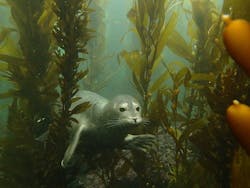Officials of the U.S. Defense Advanced Research Projects Agency (DARPA) in Arlington, Va., on Wednesday announced a potential $5.1 million contract to the Northrop Grumman Mission Systems segment in Linthicum Heights, Md., for the Persistent Aquatic Living Sensors (PALS) program.
Northrop Grumman joins Raytheon BBN Technologies in Cambridge, Mass., which won a potential $6.4 million contract for the PALS project last month.
PALS seeks to capitalize on living things in the ocean to augment existing hardware-based maritime sonar for anti-submarine warfare (ASW).
Related: Navy asks Lockheed Martin to upgrade AN/BLQ-10 submarine electronic warfare (EW) system
The project will tap into the innate abilities of marine organisms to sense and respond to disturbances caused by submarines and UUVs. The DARPA PALS contract to Northrop Grumman is for $3.2 million, and has options to increase that to $5.1 million.
DARPA, Northrop Grumman, and BBN researchers are working together to apply those abilities to detect, characterize, and report on manned or unmanned underwater vehicles ranging from small autonomous vessels to large nuclear submarines.
Because marine organisms are ubiquitous, self-replicating, and largely self-sustaining, sensing systems that use marine organisms as their foundation would be discreet, cost-effective, and provide persistent undersea surveillance with a minimal logistical footprint, DARPA officials explain.
DARPA, Northrop Grumman, and BBN are trying to develop a two-stage system that first can sense and detect the presence of an underwater vehicle and respond with an output signal or other observable behavior; and second to develop a detector to observe, record, and interpret the organisms’ responses, and report analyzed results.
The complete PALS system also will seek to discriminate between target vehicles and other sources of stimuli, such as debris and other marine organisms, to limit false alarms.
The world’s vast oceans and seas offer seemingly endless spaces where U.S. adversaries can maneuver undetected, DARPA officials say. The U.S. military deploys networks of manned and unmanned sensors to monitor adversary activity, but the scale of the task is daunting and hardware alone cannot meet every need.
Sea life, however, offers a potential new advantage, DARPA officials say. Marine organisms are attuned to their surroundings, and may be able to help monitor strategic waters such as straits and littoral regions for enemy submarines and UUVs.
DARPA, Northrop Grumman, and BBN scientists will study natural and modified organisms to determine which ones best could support sensors able to detect the movement of manned and unmanned underwater vehicles. The idea is to capture and interpret the responses of these marine organisms with networked hardware.
Related: General Dynamics to continue software upgrades on Navy AN/BYG-1 submarine combat system
“The U.S. Navy’s current approach to detecting and monitoring underwater vehicles is hardware-centric and resource-intensive," says Lori Adornato, the DARPA PALS program manager. "As a result, the capability is mostly used at the tactical level to protect high-value assets like aircraft carriers, and less so at the broader strategic level.
“If we can tap into the innate sensing capabilities of living organisms that are ubiquitous in the oceans, we can extend our ability to track adversary activity and do so discreetly, on a persistent basis, and with enough precision to characterize the size and type of adversary vehicles,” Adornato says.
Sea life adapts and responds to its environment, DARPA officials explain, prompted by evolution to sense tactile, electrical, acoustic, magnetic, chemical, and optical stimuli. Raytheon BBN researchers will develop hardware, software, and algorithms to translate organism behavior into actionable information and then communicate it to military authorities.
For more information contact Northrop Grumman Mission Systems online at www.northropgrumman.com, Raytheon BBN at www.raytheon.com/ourcompany/bbn, or DARPA at www.darpa.mil.
Ready to make a purchase? Search the Military & Aerospace Electronics Buyer's Guide for companies, new products, press releases, and videos



